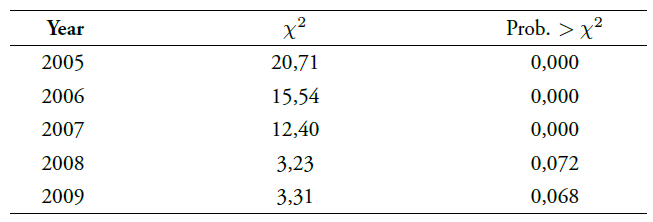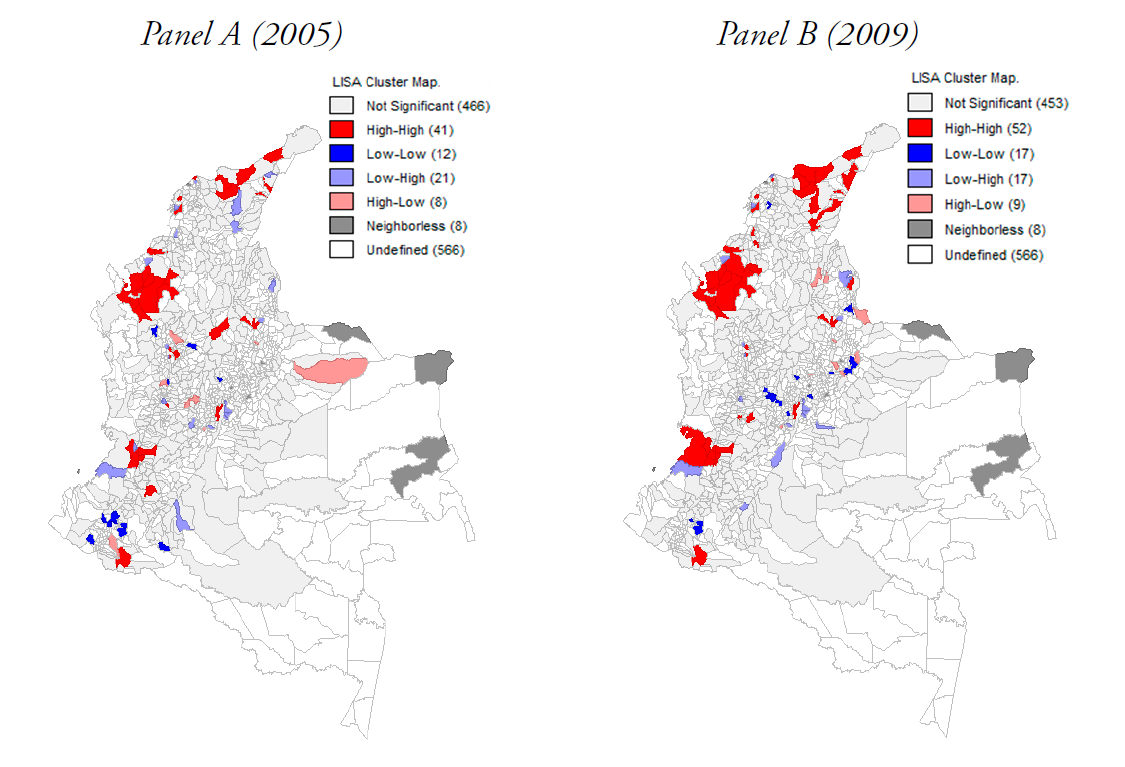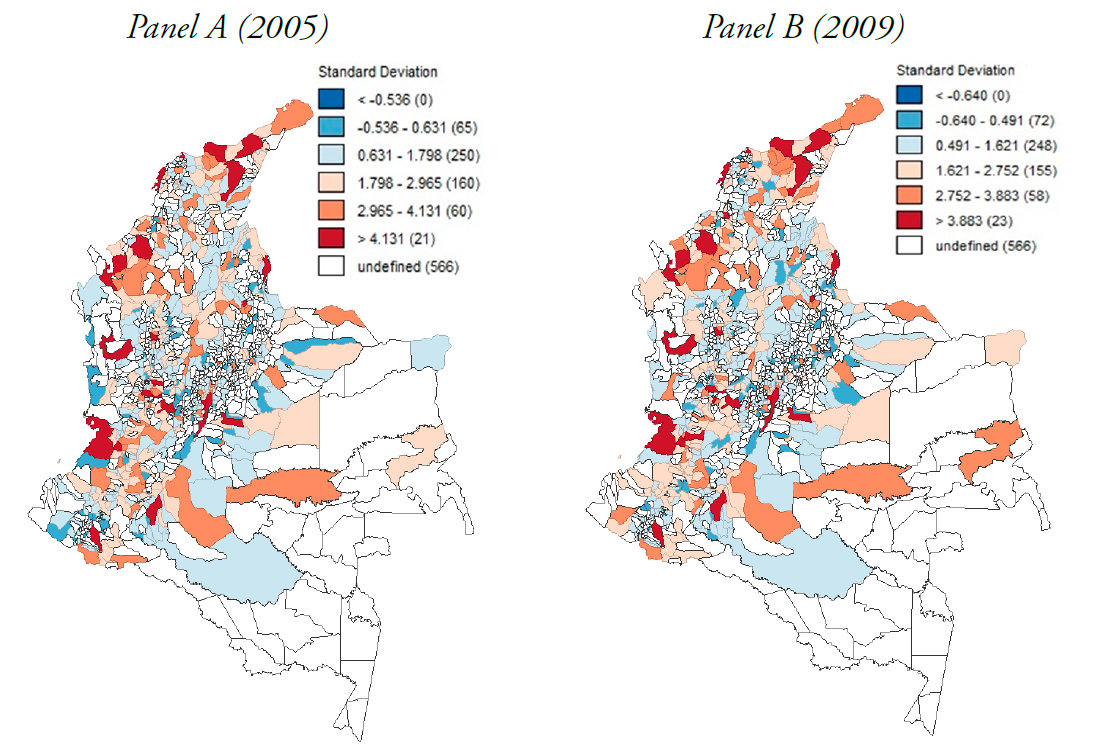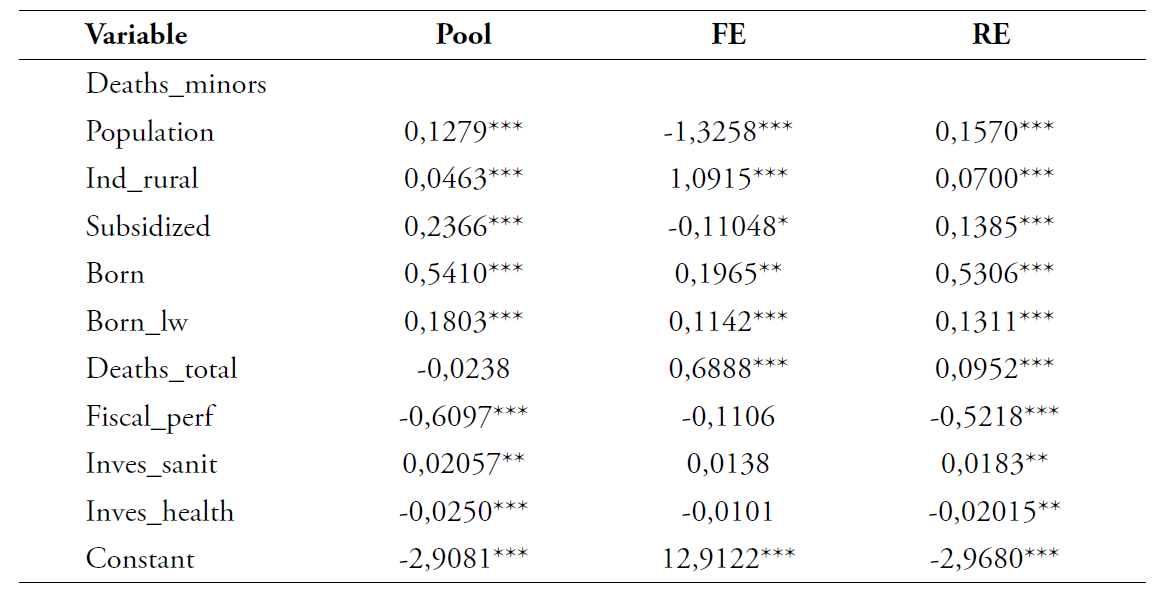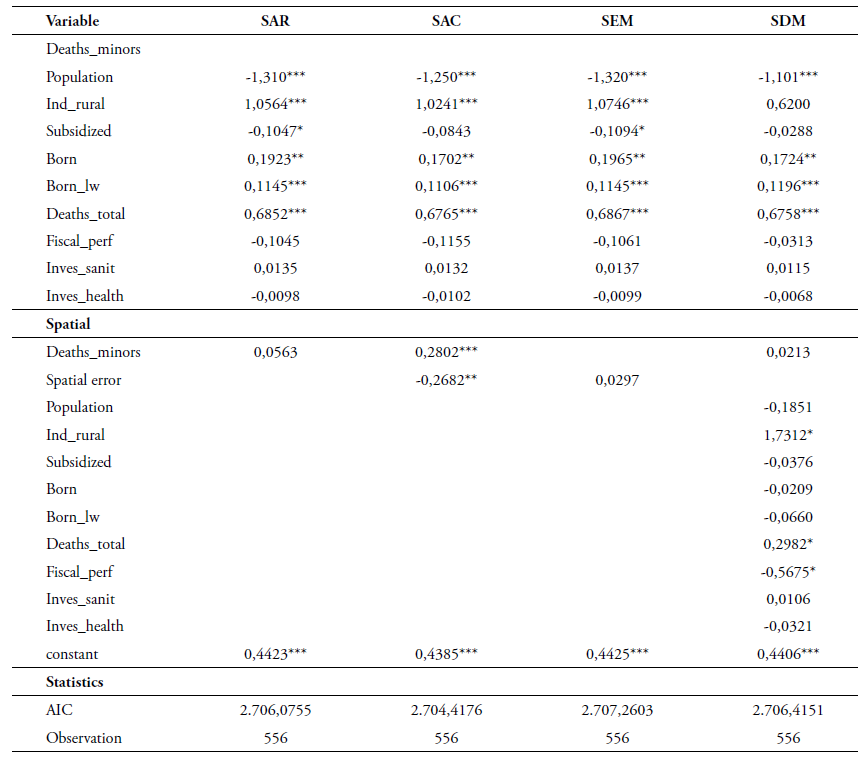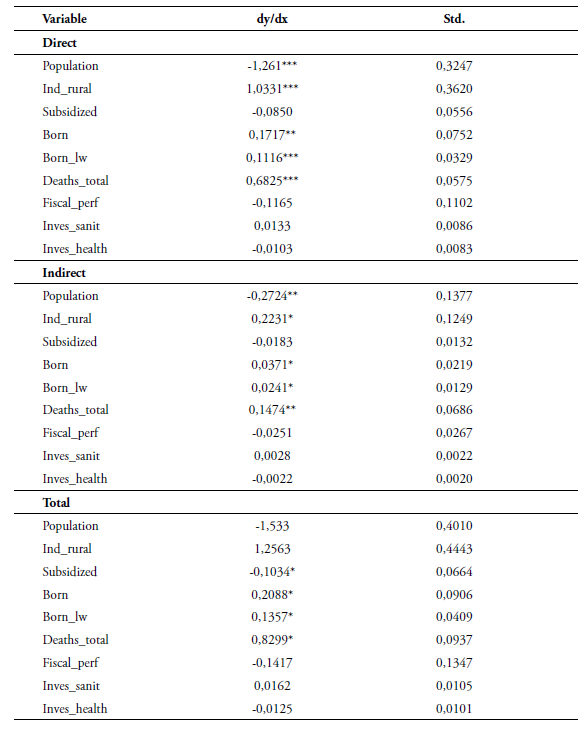Efectos de la dinámica espacial en el sistema de salud colombiano
DOI:
https://doi.org/10.17533/udea.le.n92a336897Palabras clave:
gastos del gobierno y salud, comportamiento de salud, política gubernamental, regulación, salud pública, modelos transversales, modelos espaciales, modelos de efectos de tratamiento, regresiones cuantilesResumen
Buscamos entender si la dinámica espacial afecta a la población en términos sociales, económicos y de salud. Para llevar a cabo este estudio, proponemos dos etapas. En la primera, buscamos comprender, desde la literatura y los cambios realizados en el modelo de salud colombiano, las causas de la alta mortalidad infantil en las zonas rurales en comparación con las zonas urbanas. La segunda, es un análisis econométrico espacial de las variables de interés, donde se utiliza la base de datos CEDE de la Universidad de los Andes. Los resultados de este estudio confirman la importancia de la inclusión de efectos espaciales, lo cual es una señal de que la dinámica de salud de las poblaciones está interrelacionada. Esta interdependencia espacial corrobora la sugerencia de la literatura que propone que las políticas deben estar coordinadas y considerar poblaciones locales y vecinas. Además, las administraciones municipales deberían considerar mecanismos de interlocución, mientras trabajan con sus pares, y permitir que estos factores se incluyan en la planificación de las medidas políticas en temas de salud. Finalmente, confirmamos diferencias en áreas rurales y urbanas.
Descargas
Citas
Balk, D., Pullum, T., Storeygard, A., Greenwell, F. & Neuman, M. (2004). A spatial analysis of childhood mortality in West Africa. Population. Space and Place, 10(3), 175-216.
Baltagi, B. H., Moscone, F. & Santos, R. (2018). Spatial Health Econometrics. Health Econometrics (Contributions to Economic Analysis, Volume 294), Emerald Publishing Limited.
Banerjee, S., Wall, M. M. & Carlin, B. P. (2003). Frailty modeling for spatially correlated survival data, with application to infant mortality in Minnesota. Biostatistics, 4(1), 123-142.
Barufi, A. M., Haddad, E., & Paez, A. (2012). Infant mortality in Brazil, 1980-2000: A spatial panel data analysis. BMC public health, 12(181).
Cáceres-Manrique, F. M. (2009). El control prenatal: una reflexión urgente. Revista Colombiana de Obstetricia y Ginecología, 60(2), 165-170.
Carrillo, A. (2007). Mortalidad materna en Colombia: reflexiones en torno a la situación y la política pública durante la última década. Revista Ciencias de la Salud, 5(2), 72-85.
Donabedian, A. (1978). The quality of medical care. Science, 200(4344), 856-864.
Donabedian, A., Wheeler, J. R. & Wyszewianski, L. (1982). Quality, cost, and health: an integrative model. Medical Care, 20(10), 975-992.
Elhorst, J. P. (2014). Linear spatial dependence models for cross-section data. Spatial Econometrics (pp. 5-36). Berlin, Heidelberg: Springer.
Escallon, V. J., Rodriguez-Pineda, L. & Rivera, L. (2015). Modelo del comportamiento de las listas de espera en pacientes de cirugías electivas en el sistema de salud colombiano. XIII Congreso latinoamericano de Dinámica de Sistemas. Cartagena de indias.
Gamper-Rabindran, S., Khan, S. & Timmins, C. (2010). The impact of piped water provision on infant mortality in Brazil: A quantile panel data approach. Journal of Development Economics, 92(2), 188-200.
Gemperli, A., Vounatsou, P., Kleinschmidt, I. B., Lengeler, C. & Smith, T. (2004). Spatial patterns of infant mortality in Mali: the effect of malaria endemicity. American Journal of Epidemiology, 159(1), 64-72.
Guerrero, R., Gallego, A. I., Becerril-Montekio, V. & Vásquez, J. (2011). Sistema de salud de Colombia. Salud Pública de México, 53, 144-155.
Jeleskovic, V. & Schwanebeck, B. (2012). Assessment of a spatial panel model for the efficiency analysis of the heterogonous healthcare systems in the world. Joint Discussion Paper Series in Economics, (18).
Kalipeni, E. (1993). Determinants of infant mortality in Malawi: a spatial perspective. Social Science & Medicine, 37(2), 183-198.
Luján, F. J. (2010). Luces y sombras de la reforma de la salud en Colombia: Ley 100 de 1993. Bogotá: Assalud.
Maine, D., Akalin, M. Z., Ward, V. M. & Kamara, A. (1997). Diseño y evaluación de programas para mortalidad materna. New York: Centro para la Población y Salud Familiar. Facultad de Salud Pública, Universidad de Columbia.
Ministerio de Salud y Protección Social (2016a). Análisis de Situación de Salud. Colombia, 2015. Bogotá: Imprenta Nacional de Colombia.
Ministerio de Salud y Protección Social (2016b). Política de atención integral en salud. Un sistema de salud al servicio de la gente.Recuperado de: www.minsalud.gov.co/sites/rid/Lists/BibliotecaDigital/RIDE/DE/modelo-pais-2016.pdf
Pan American Health Organization (PAHO) (28 de Mayo de 2010). La Renovación de la Atención primaria de Salud en las Américas. Redes Integradas de Servicio de Salud: Conceptos, Opciones de Política y hoja de Ruta para su implementación en las Ámericas, 4. Washington D.C. Recuperado de : https://www.paho.org/uru/index.php?option=com_docman&view=download&alias=145-redes-integradas-de-servicios-de-salud-aps-n4&category_slug=publicaciones-sistemas-y-servicios-desalud&Itemid=307
Padilla, C. M., Deguen, S., Lalloue, B., Blanchard, O., Beaugard, C., Troude, F., . . . Vieira, V. M. (2013). Cluster analysis of social and environment inequalities of infant mortality. A spatial study in small areas revealed by local disease mapping in France. Science of The Total Environment, 454-455(1), 433-441.
Pazmiño de Osorio, S. & Guzmán-Gómez, N. (2009). Control prenatal y su impacto en la mortalidad materna: Análisis de una tendencia. Revista Colombiana de Obstetricia y Ginecología, 60(1), 12-18.
Programa de las Naciones Unidas para el Desarrollo (PNUD) (2015). Objetivos de desarrollo del Milenio. Bogotá: Nuevas Ediciones S.A.
Rushton, G. (2003). Public health, GIS, and spatial analytic tools. Annual Review of Public Health, 24(1), 43-56.
Rushton, G., Krishnamurty R., Krishnamurti, D., Lolonis, P. & Song, H. (1996). The spatial relationship between infant mortality and birth defect rates in a US city. Statistics in Medicine, 15(18), 1907-1919.
Storeygard, A., Balk, D., Levy, M. & Deane, G. (2008). The global distribution of infant mortality: a subnational spatial view. Population, Space and Place, 14(3), 209-229.
Torres-Preciado, V. H., Polanco-Gaytán, M. & Tinoco-Zermeño, M. A. (2017). Crime and regional economic growth in Mexico: a spatial perspective. Papers in Regional Science, 96(3), 477-494.
Vélez Álvarez, G. A., Gallego Vélez, L. I. & Jaramillo Posada, D. C. (2005). Modelo de análisis de la muerte materna: Camino para la supervivencia. En Gallego, L., Gómez, J. y Escobar, A. Modelos para el análisis de la mortalidad materna y perinatal (33-44). Medellín: Secretaría de Salud, Alcaldía de Medellín.
Publicado
Cómo citar
Número
Sección
Licencia
Derechos de autor 2020 Leonardo Rodriguez-Pineda, Andrés Felipe Sánchez Saldarriaga, Helena María Cancelado Carretero

Esta obra está bajo una licencia internacional Creative Commons Atribución-NoComercial-CompartirIgual 4.0.
Este sitio web, por Universidad de Antioquia, está licenciado bajo una Creative Commons Attribution License.
Los autores que publiquen en esta revista aceptan que conservan los derechos de autor y ceden a la revista el derecho de la primera publicación, con el trabajo registrado con una Licencia de Atribución-NoComercial-CompartirIgual de Creative Commons, que permite a terceros utilizar lo publicado siempre que mencionen su autoría y a la publicación original en esta revista.
Los autores pueden realizar acuerdos contractuales independientes y adicionales para la distribución no exclusiva de la versión del trabajo publicada en la revista (por ejemplo, incluirla en un repositorio institucional o publicarla en un libro) siempre que sea con fines no comerciales y se reconozca de manera clara y explícita que el artículo ha sido originalmente publicado en esta revista.
Se permite y recomienda a los autores publicar sus artículos en Internet (por ejemplo, en páginas institucionales o personales), ya que puede conducir a intercambios provechosos y a una mayor difusión y citación de los trabajos publicados.









 denotes the municipalities and the year,
denotes the municipalities and the year,  denotes the dependent variable and
denotes the dependent variable and  the group of explanatory variables. Also,
the group of explanatory variables. Also,  and
and  refers to the spatial effects of the dependent variable and the errors respectively.
refers to the spatial effects of the dependent variable and the errors respectively.